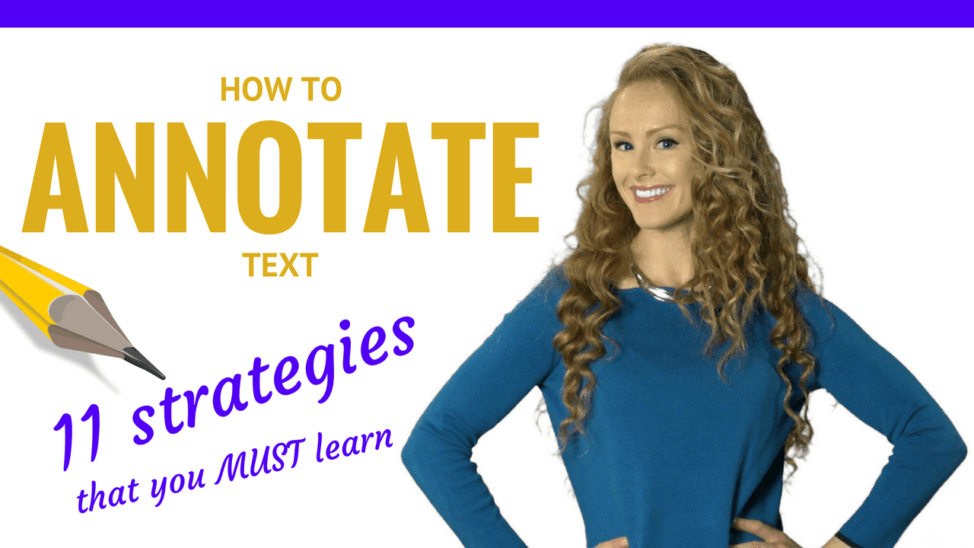By Katie Azevedo, M.Ed.
Annotating a book or an article is a fundamental school habit that you’ll want to develop as early as possible. As you move through school and your texts get harder and harder, you’ll need to know how to annotate text while reading.
First things first: Annotating means taking notes on a text – – either on a book or an article or something similar. So to annotate means to take notes.
You might be wondering why the heck you would annotate anyway(?). For so many reasons! The most important reason you would annotate is for a deep understanding of the material. Taking notes on your text helps you comprehend what you’re reading on a much deeper level than if you were to just read it straight through.
In this tutorial I’m teaching you how to annotate, but to get the most complete instruction, be sure to avoid these 6 common annotation mistakes.
4 major benefits of annotating:
- It keeps you awake and engaged as you read, and reduces your chances of “fake reading syndrome.”
- It helps you process what you’re reading as you’re reading it.
- It slows down your reading, which is actually a good thing. Decreasing your pace can often increase your comprehension and retention.
- It double-whammies as a way to quickly find information later on. In other words, when you go back into the book to find something later, you can just read your annotations, which is faster than reading the actual text a second time through.
So how do you annotate? There are so many ways. Just as there are so many types of learners, there are so many techniques that suit different students. You might have to experiment for a while to see what does and does not work for you, but there are some basic annotation principals, or rules, to keep in mind as you figure out your own system.
How to annotate text while reading: 11 annotation strategies you might find helpful:
- Circle unfamiliar words. Then look them up, and write down the definition.
- Use question marks to indicate areas of uncertainty.
- Use stars to indicate anything that seems important, such as themes, symbols, foreshadowing, etc.
- Use exclamation points to indicate something dramatic, or a key turning point.
- Circle character names any time they are introduced for the first time.
- Keep a list somewhere, maybe on the inside cover, of all the characters and their traits. Add to this list as new characters are introduced, or as you learn more about existing characters.
- Write your notes in the margins (best method), on sticky-notes (decent method), or in a separate notebook (least favorable method).
- Paraphrase (summarize) each chapter after you finish reading it. You only need a few sentences to do this. Write it down at the beginning or end of the chapter.
- Write down any questions you have about the text – either questions you’re willing to wait to find out the answer to as you read further, or questions you want to bring up to your teacher in class the next day.
- Use a color-coded system if that type of thing appeals to you. (Colors! Yes!)
- Give each chapter a title. After you finish reading each chapter, go back to its title page and give it a title. The title should simply be the main idea of the chapter, or a statement about the main event in the chapter. If the chapter already has a title, it’s likely just catchy and not helpful, so still go ahead and title it yourself.
- BONUS TIP: Become a master of the Highlight and Rewrite Strategy.
Note: If you’re reading a text on your tablet or ipad, you can still annotate! There are so many cool apps that allow you to circle, underline, highlight, doodle, whatever. Just do a basic search for “annotation apps” and you’ll find a bunch. iannotatepdf is a good one, as is LuminPDF and Notability.
One of the most important annotation strategies
When you’re reading and annotating, keep in mind that your notes should represent your thoughts. Your notes should represent your interaction with the story, the author, the characters, etc. Don’t worry about writing down “smart-sounding” notes just because you think that’s what your teacher wants. Let your annotations really reflect your true thoughts and feelings as you read. If you really listen to your inner voice as you read – the voice that says “Huh? Why did that happen?” or “That’s awesome!” or “That’s not a good sign,” then the whole process of annotating is so much easier.
Annotating text is a skill that gets easier the more you do it. As you first start off, you might not annotate much at all because you’re not sure where to start. (If that’s the case, keep checking back to my list of 11 annotation techniques to remind yourself of how to do it.) And it’s okay to be reserved as you start – you’ll figure it out soon enough.
But I’ve also seen the opposite, where a student underlines every single word on a page, or highlights the entire article or chapter. When you do this, nothing stands out, which defeats the purpose of taking notes in the first place.
Also, while annotating is an excellent skill that allows you to get that deep, close understanding of a text, you don’t need to do it all the time. If you’re reading a book for pleasure, just relax and read the book. If you’re reading an article in one of your favorite magazines, just relax and read the article. No need to make a job out of something that’s supposed to bring you joy.
Learning how to annotate text while reading can bring your reading comprehension to the next level. Try it. Why not?
If you’re struggling with taking notes during class, then check out my tutorials on that type of annotation:
- How to take notes in a lecture class
- How to know what to write down
- Note-taking tips for students with ADHD

